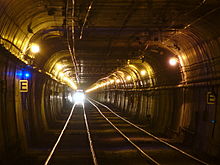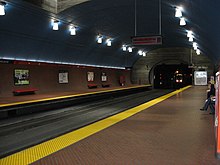Twin Peaks Tunnel
 Twin Peaks Tunnel at Forest Hill Station | |
| Overview | |
|---|---|
| Line | |
| Location | San Francisco, California |
| Coordinates | East portal: 37°45′43″N 122°26′13″W / 37.76194°N 122.43694°W West portal: 37°44′29″N 122°27′56″W / 37.74139°N 122.46556°W |
| System | Muni Metro |
| Start | Eureka Station (closed) |
| End | West Portal Station |
| No. of stations | 3 (2 open, 1 closed) |
| Operation | |
| Opened | February 3, 1918 |
| Owner | San Francisco Municipal Transportation Agency |
| Operator | San Francisco Municipal Railway |
| Character | Underground subway tunnel for light rail/streetcar system |
| Technical | |
| Line length | 2.27 mi (3.65 km) |
| No. of tracks | 2 |
| Track gauge | 4 ft 8+1⁄2 in (1,435 mm) (standard gauge) |
| Electrified | Overhead lines, 600 V DC |
| Tunnel clearance | 25 ft (7.6 m)[1] |
| Route map | |
| Template:Infobox rdt | |
The Twin Peaks Tunnel is a 2.27-mile (3.65 km)-long[1] light rail/streetcar tunnel in San Francisco, California. The tunnel runs under the Twin Peaks and is used by the K Ingleside, L Taraval, M Ocean View, and T Third Street Muni Metro lines. The S Castro Shuttle also uses the tunnel for AT&T Park game day runs.

History and background
The tunnel was opened on February 3, 1918.[1] The eastern entrance to the tunnel is located near the intersection of Market and Castro streets in the Castro neighborhood, and the western entrance is located at West Portal Avenue and Ulloa Street in the West Portal neighborhood.
The service through the tunnel has evolved from streetcars into light rail, and while there are longer light-rail tunnels elsewhere (such as Portland's Robertson Tunnel), the Twin Peaks Tunnel remains one of the world's longest streetcar or light-rail tunnels.[citation needed] There are two stations along the tunnel, Forest Hill Station, near the western end, and the now disused Eureka Station, near the eastern end.
When the Muni Metro system and Market Street Subway were built, they were connected to the Twin Peaks Tunnel to be used by the K Ingleside, L Taraval and M Ocean View lines. The Eureka Station was closed, and the Metro lines stop at the nearby Castro Street Station instead.

The original eastern entrance to the tunnel in the middle of Market Street at Castro was removed and new entrances were placed on the sides of the street further up the block, though no Metro or streetcar lines use them in regular service (they were used during construction of the Market Street subway and are occasionally used in non-revenue service such as rerouting trains around construction projects). Instead, trains continue directly from the Market Street Subway into the tunnel without going above ground. West Portal Station, which was originally a surface stop outside of the tunnel's western entrance, was rebuilt as a high-platform station located just inside of the entrance.
Silent film of tunnel construction
In 2011, the Niles Silent Film Museum in Niles, California discovered a 19-minute silent film of the construction of the tunnel, produced by Baldwin and Howell Real Estate Co. of San Francisco. The film was restored with the help of the National Film Preservation Foundation. (See External Links.)
See also
References
- ^ a b c Wallace, Kevin (March 27, 1949). "San Francisco History - City's Tunnels". San Francisco Chronicle. Retrieved July 14, 2008.
{{cite web}}: Italic or bold markup not allowed in:|publisher=(help)
